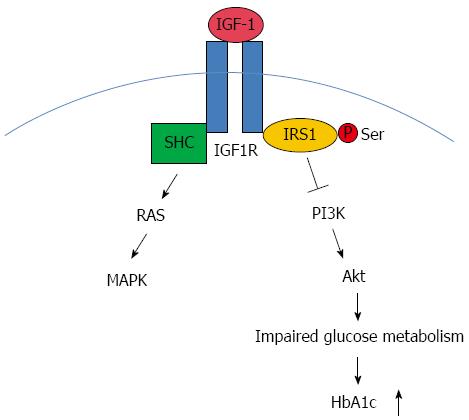Copyright
©The Author(s) 2015.
World J Gastroenterol. Nov 28, 2015; 21(44): 12593-12604
Published online Nov 28, 2015. doi: 10.3748/wjg.v21.i44.12593
Published online Nov 28, 2015. doi: 10.3748/wjg.v21.i44.12593
Figure 6 Insulin-like growth factor-1 signaling with regard to Helicobacter pylori associated glucose dysregulation.
Insulin-like growth factor-1 (IGF-1), upon binding to its receptor IGF-1R, activates the intrinsic tyrosine kinase activity. IGF-1R then phosphorylates substrate proteins, including members of the IRS family such as IRS1 and Shc on selective tyrosine residues. Downstream to the receptors are two major pathways: the phosphatidylinositol-3 kinase (PI3K)/Akt pathway and MAPK pathway. IGF-1 acts via the MAPK pathway to mediate growth responses. The PI3K pathway is thought to have predominantly metabolic effects. We supposed that this pathway might play a part in Helicobacter pylori (H. pylori) associated abnormal glucose metabolism and the upregulation of HbA1c. SHC: Spontaneous human combustion.
-
Citation: Yang Z, Li W, He C, Xie C, Zhu Y, Lu NH. Potential effect of chronic
Helicobacter pylori infection on glucose metabolism of Mongolian gerbils. World J Gastroenterol 2015; 21(44): 12593-12604 - URL: https://www.wjgnet.com/1007-9327/full/v21/i44/12593.htm
- DOI: https://dx.doi.org/10.3748/wjg.v21.i44.12593









